Lessico
Aldrovandia
vesiculosa
ex Aldrovanda vesiculosa di Linneo
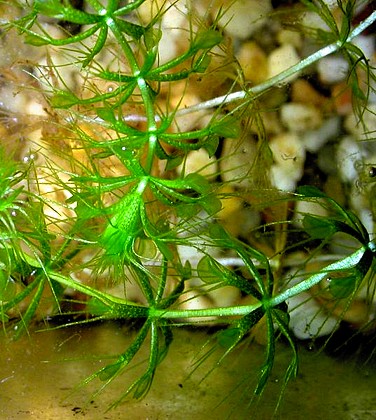
L'Aldrovanda vesiculosa è una pianta acquatica appartenente alla famiglia delle Droseraceae, diffusa in Europa, Asia, Africa ed Australia. È una pianta carnivora che vegeta sia nelle zone temperate che in quelle tropicali.
Il nome
datole nel 1747 da Giuseppe Monti (1682-1760), professore e direttore
dell’Orto Botanico di Bologna (1722-60), era Aldrovandia, ma sei anni
dopo, e precisamente nel 1753, Linneo![]() nel suo Species
Plantarum la battezzò in modo lievemente diverso, cioè Aldrovanda,
omettendo – a quanto pare per errore – la i. Errore, o pseudoerrore, che si è trasmesso
nelle plurime edizioni delle opere di Linneo giungendo fino a noi.
nel suo Species
Plantarum la battezzò in modo lievemente diverso, cioè Aldrovanda,
omettendo – a quanto pare per errore – la i. Errore, o pseudoerrore, che si è trasmesso
nelle plurime edizioni delle opere di Linneo giungendo fino a noi.
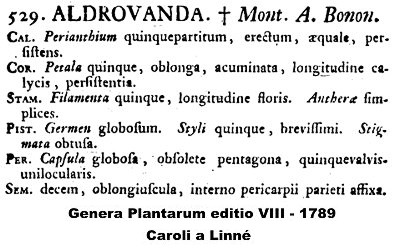
Nessuno
finora ha ufficialmente preteso di onorare Monti chiamando Aldrovandia l'Aldrovanda,
così come la Gesneria![]() non si chiama Gesnera.
Ma Linneo aveva eluso Charles Plumier
non si chiama Gesnera.
Ma Linneo aveva eluso Charles Plumier![]() battezzando la sua Gesneria in Gesnera. Alcuni decenni più
tardi (1810) Alexandre de Théis dava ragione al monaco e botanico suo
connazionale e riportava Gesneria.
battezzando la sua Gesneria in Gesnera. Alcuni decenni più
tardi (1810) Alexandre de Théis dava ragione al monaco e botanico suo
connazionale e riportava Gesneria.
Forse, non essendo connazionale di Aldrovandi, Théis lascia intonso Aldrovanda di Linneo, addirittura dà a Ulisse il cognome Aldrovanda, ma gli chiede indirettamente scusa facendolo morire a 183 anni, nel 1705 anziché nel 1605. Salvo che in Francia la fama e le notizie biografiche di Ulisse fossero abbastanza confuse, tanto da rendere Ulisse un contemporaneo di Plumier.

Sorte
ben diversa toccò a Leonhart Fuchs![]() ,
in quanto Linneo, ispirato da Plumier, accettò di denominare Fuchsia e
non Fuchsa il genere Fuchsia, che nell'indice di Genera
Plantarum di Linneo non ha altri equivalenti. Misteri dell'onomastica
linneana!
,
in quanto Linneo, ispirato da Plumier, accettò di denominare Fuchsia e
non Fuchsa il genere Fuchsia, che nell'indice di Genera
Plantarum di Linneo non ha altri equivalenti. Misteri dell'onomastica
linneana!
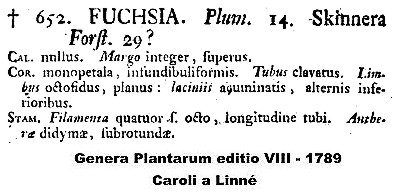
Oggi - 26 aprile 2008 - mi permetto di emendare la pianta Aldrovanda con Aldrovand<i>a, corroborato dal fatto che già nel 1973 la Grande Enciclopedia del Giardinaggio dell'editore Armando Curcio riportava Aldrovandia. Giustizia è fatta, visto che Aldrovandi è un mio connazionale, nonostante mi permetta di criticarlo a ogni piè sospinto.
Invece a
qualcuno è saltato in mente di disonorare ufficialmente Linneo e di mandare Adone a
Casablanca per renderlo femmina, trasformando il linneano maschile Adonis annuus
nel femminile Adonis
annua![]() .
.
Questa carnivora - l'Aldrovandia vesiculosa - galleggia in acque solitamente molto calme, non presenta radici e si sviluppa in filamenti, divisi in nodi e internodi, che possono raggiungere i 20-25 cm di lunghezza. Da un lato del filamento avviene la crescita, mentre dalla parte opposta la pianta muore progressivamente. Le foglie, che originano agli internodi, sono rette da un picciolo lungo sino a 9 mm. I fiori, di colore bianco-verdastro, hanno 5 petali lunghi 4-5 mm.
Si diversifica dalle altre piante carnivore acquatiche (Utricularia, genere di piante erbacee della famiglia Lentibulariacee) per la struttura delle sue trappole che sono praticamente identiche a quelle della droseracea Dionaea muscipula, una fra le più note piante carnivore, detta comunemente pigliamosche.
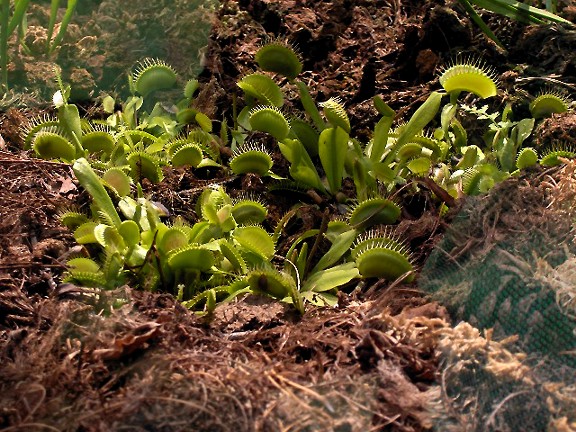
Dionaea muscipula
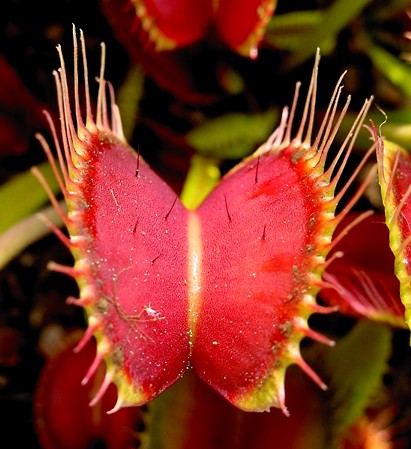
Recenti ricerche sul DNA hanno dimostrato scientificamente che Aldrovanda e Dionaea muscipula sono strettamente imparentate tra loro. Le trappole dell'Aldrovanda sono composte infatti da due lembi sulla superficie dei quali troviamo numerosi trigger o recettori (la Dionaea ne possiede solamente 3 per ogni foglia).
La tecnica di cattura è simile a quella della Dionaea, ma ben diversa è la velocità con la quale la trappola scatta. Il tempo impiegato per la chiusura è stimato in 1/4 di secondo, una velocità impressionante se si tiene conto del fatto che la trappola chiudendosi deve vincere la resistenza dell'acqua che ne rallenta i movimenti.
Inizialmente, la preda rimane bloccata nella zona periferica della trappola, dove alcune ghiandole sono in grado di percepire l'odore molecolare della preda. Nel caso in cui a far scattare la trappola non fosse una vera preda, questa si riapre in un lasso di tempo che varia dalle 10 alle 20 ore, diversamente, altre ghiandole pompano acqua al suo interno spingendone la preda verso il centro, denominata anche "zona di digestione", dove potenti acidi iniziano ad assimilare la preda nell'arco 30 minuti.
Terminato il processo di digestione, nei successivi 7 giorni (circa) la trappola si riapre preparandosi alla la cattura di nuove prede. Questa specie di carnivora predilige larve di zanzare e pulci d'acqua.
L'Aldrovanda vesiculosa che vive nelle zone temperate necessita di un riposo invernale, periodo durante il quale si chiude in piccoli ibernacoli, da cui nascono nuove piante con l'arrivo della primavera, che coincide con il loro periodo vegetativo.
La moltiplicazione di questa pianta, avviene per separazione, ovvero si disgiungono alcune ramificazioni che con il tempo tendono a crescere formando nuove trappole.
Aldrovanda vesiculosa è una delle specie di piante carnivore con la più ampia distribuzione, essendo diffusa in Europa, Asia, Africa e Australia. Nonostante l'ampiezza dell'areale è considerata una pianta rara.
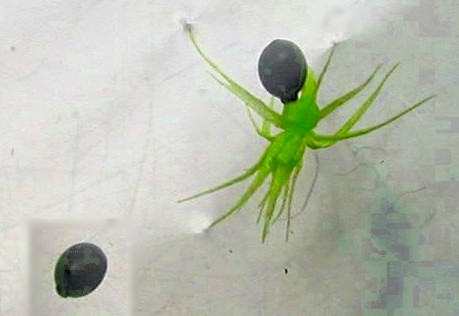
Germinating seeds
Aldrovanda vesiculosa, known as the waterwheel plant, is the sole extant species in the flowering plant genus Aldrovanda of the family Droseraceae. This plant feeds on small aquatic invertebrates using traps very similar to those of the Venus Flytrap (Dionaea muscipula). The traps are arranged in whorls around a central, free-floating stem, hence the common name. This plant is one of the few plants capable of rapid plant movement.
While the genus Aldrovanda is monotypic, extinct species are known to have existed. There is also wide variability among populations of significantly different geographic locations, as the species is found natively on four continents.
Aldrovanda vesiculosa was discovered in India in 1699 by Leonard Plukenet, who named the plant Lenticula pulustris Indica. The modern botanical name originates from Giuseppe Monti, who described Italian specimens in 1747 and named them Aldrovandia vesiculosa in honor of the Italian naturalist Ulisse Aldrovandi. When Carl Linnaeus published his Species Plantarum in 1753, the "i" was dropped from the name (an apparent orthographic error) to form the modern binomial.
Aldrovanda vesiculosa is a rootless aquatic plant; only seedlings possess rudimentary roots, which however soon die off. The plant consists of floating stems reaching a length of 6-11 cm. The 2-3 mm trap leaves grow in whorls of 5-9 in close succession along the plant's central stem. The actual traps are held by petioles which hold air sacks that aid in flotation. One end of the stem continually grows while the other end dies off. Growth is quite rapid (4-9 mm/day in Japanese populations), so that in optimal conditions a new whorl is produced once or more a day.
The actual traps consist of two lobes which fold together to form a snap-trap similar to that of the Venus Flytrap. These traps, which are twisted so that the trap openings point outward, are lined on the inside by a fine coating of trigger hairs, snapping shut in response to contact with aquatic invertebrates and trapping them. The closing of this trap takes a mere 0.01-0.02 seconds, making it one of the fastest examples of plant movement in the kingdom. This trapping is only possible in warm conditions (20 °C). Each trap is surrounded by between four and six 6-8 mm long bristles which prevent triggering of traps by debris in the water.
The small, solitary white flowers of Aldrovanda vesiculosa are supported above the water level by short peduncles which arise from whorl axes. The flower only opens for a few hours, after which the structure is brought back beneath the water level for seed production. The seeds are cryptocotylar, meaning that the cotyledons remain hidden within the seed coat and serve as energy storage for the seedlings. The waterwheel plant, however, seems to bloom seldom, at least in temperate regions.
Aldrovanda vesiculosa reproduces most often through vegetative reproduction. In favourable conditions, adult plants will produce an offshoot every 3-4 cm, resulting in new plants as the tips continue to grow and the old ends die off and separate. Due to the rapid growth rate of this species, countless new plants can be produced in a short period of time in this fashion.
Winter-hardy Aldrovanda form so-called "turions" as a frost survival strategy. At the onset of winter, the growth tip starts producing highly reduced non-carnivorous leaves on a severely shortened stem. This results in a tight bud of protective leaves which, being heavier and having released flotational gases, breaks off of the mother plant and sinks to the water bottom, where temperatures are stable and warmer. Here it can withstand temperatures as low as -15 °C (-5 °F). In the wild, Aldrovanda turions have been observed to have a relatively low rate of successful sinking.[9] Those nutritious turions that fail to sink are then grazed by waterfowl or are killed by the onset of frost. In spring when water temperatures rise above 12-15°C, turions reduce their density and float to the top of the water, where they germinate and resume growth. Non-dormant turion-like organs can also form in response to summer drought.
Aldrovanda vesiculosa is the most widely distributed carnivorous plant species, native to Europe, Asia, Africa, and Australia. It is, however, rare in all of its range. Aldrovanda is spread mainly through the movement of waterfowl - plants sticking to the feet of a bird are transported to the next aquatic destination on the bird's route. As a result, most Aldrovanda populations are located along avian migratory routes.
Aldrovanda vesiculosa prefers clean, shallow, warm standing water with bright light, low nutrient levels and a slightly acidic pH (around 6). It can be found floating amongst Juncus, reeds, and even rice.
The Carnivorous Plant
courtesy
of
The International Carnivorous Plant Society
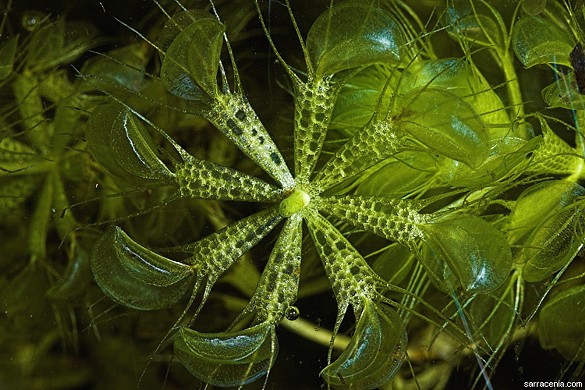
Aldrovanda is a free-floating and rootless aquatic plant. This plant is closely related to the Venus flytrap Dionaea muscipula, and shares many of its attributes -- it functions as a snap-trap carnivore, just under water! A common name for it is the waterwheel plant because a single whorl of leaves, cut from a stem, is wheel-like, as you can see below!
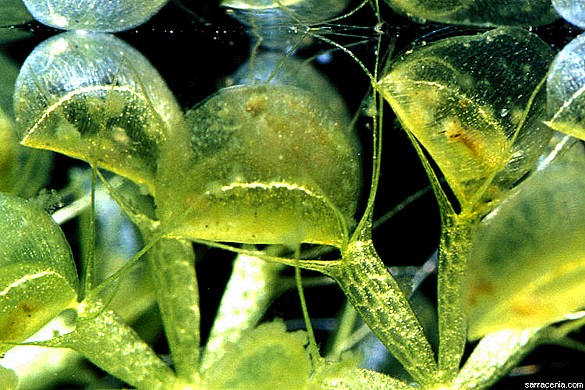
The
genus name commemorates the Italian naturalist Ulisse Aldrovandi (1522-1605).
In fact, the name for the genus was originally "Aldrovandia", but
Linnaeus misspelled this, and we use the incorrect spelling even today.
Each leaf in a whorl terminates in a little clam-like trap. Exactly how the
trap captures prey is a little complicated. Just like the traps of a Venus
flytrap, the trap lobes of Aldrovanda contain trigger hairs. When
stimulated, these cause the traps to close. SNAP! The closure takes about 1/4
to 1/2 second, which is impressive when you reflect upon the fact that the
trap lobes must push water as they close. If no prey is captured, the trap
reopens in ten to twenty hours.
The strange snapping behavior of the plant was observed by De Sassus as early as 1861, but it was not until Darwin's careful work was there proof it was probably carnivorous. We now know that indeed, the traps produce phosphate-digesting enzymes, and that traps fed with radioisotope-labeled Daphnia (water flea) absorb the prey.
www.sarracenia.com
Dafnia
Daphnia è un genere di Crostacei Branchiopodi dell'ordine Cladoceri famiglia Dafnidi, comprendente numerose specie, alcune delle quali caratteristiche delle piccole raccolte d'acqua, altre proprie del plancton lacustre. Queste ultime hanno un ruolo importantissimo nell'alimentazione delle specie ittiche planctofaghe. Lunghe 1-2 mm, le dafnie sono caratterizzate, tra l'altro, da un grande occhio composto e da due robuste antenne ramificate. Tra le specie principali Daphnia pulex, Daphnia magna e Daphnia longispina.
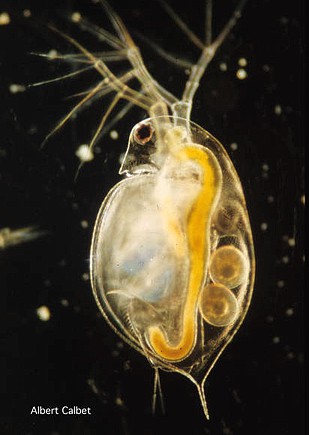
Daphnia pules
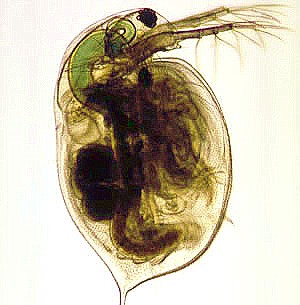
Daphnia magna